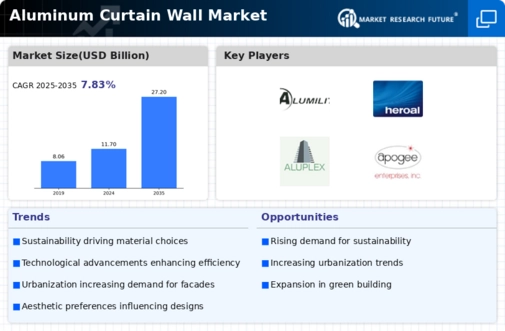Market Trends
Key Emerging Trends in the Aluminum Curtain Wall Market
The aluminum curtain wall market has seen notable trends in recent years, driven by various factors influencing construction practices, architectural design preferences, and technological advancements. One significant trend shaping this market is the increasing demand for sustainable and energy-efficient building solutions. With growing awareness of environmental concerns and stringent regulations aimed at reducing carbon emissions, there is a rising preference for building materials that contribute to energy conservation and sustainability. Aluminum curtain walls, known for their lightweight properties, durability, and recyclability, are increasingly being chosen as an eco-friendly option for building facades. These curtain walls can incorporate energy-efficient glazing systems, thermal breaks, and insulation materials to enhance building performance and reduce energy consumption, aligning with the growing emphasis on sustainable construction practices.
the products so available at high price restraints up the market size and the market growth during the market forecast period. Another restraining factor is the COVID 19 that had a very bad impact on the world which affected the construction activities. Growth in the installation costs and decrease in the site operations restrains the market size. Moreover, a reduction in the quality of the materials decreases the growth.
Another key trend in the aluminum curtain wall market is the shift towards innovative design and customization. Architects and building designers are increasingly seeking unique and visually striking facades that stand out in the urban landscape. Aluminum curtain walls offer design flexibility, allowing for the creation of complex geometric shapes, curved structures, and visually appealing patterns. Manufacturers are responding to this trend by offering a wide range of customization options, including various finishes, colors, textures, and configurations to meet the diverse design requirements of modern construction projects. Additionally, advancements in digital design tools and manufacturing techniques have enabled the realization of intricate and customized curtain wall designs, driving innovation in the market.
Technological advancements are also driving market trends in the aluminum curtain wall industry. The adoption of advanced manufacturing technologies such as computer-aided design (CAD), computer numerical control (CNC) machining, and Building Information Modeling (BIM) has enabled manufacturers to streamline the design, fabrication, and installation processes of curtain walls. Digital fabrication technologies, such as 3D printing and robotic assembly, are also being utilized to enhance the efficiency and precision of curtain wall manufacturing, leading to shorter lead times and improved product quality. Furthermore, the integration of smart technologies into curtain wall systems, such as sensor-based monitoring and automation for adaptive shading and ventilation, is gaining traction, offering enhanced functionality and performance.
Moreover, the aluminum curtain wall market is witnessing growth due to increasing investments in infrastructure development and urbanization worldwide. Rapid urbanization, particularly in emerging economies, has led to a surge in construction activities, driving the demand for curtain wall systems in commercial, residential, and institutional buildings. Additionally, the growing trend towards mixed-use developments, high-rise buildings, and sustainable urban planning initiatives is fueling the adoption of aluminum curtain walls as a versatile and aesthetically pleasing solution for modern architectural designs.
On the other hand, the aluminum curtain wall market faces challenges such as fluctuating raw material prices, supply chain disruptions, and regulatory constraints. Fluctuations in aluminum prices, influenced by factors such as global economic conditions and trade policies, can impact the production costs and profit margins of curtain wall manufacturers. Supply chain disruptions, including transportation delays and material shortages, can also pose challenges for timely project delivery and installation. Moreover, regulatory requirements related to building codes, safety standards, and environmental regulations can influence the design, fabrication, and installation practices of aluminum curtain walls, requiring manufacturers to stay abreast of evolving regulations and compliance requirements.








Leave a Comment